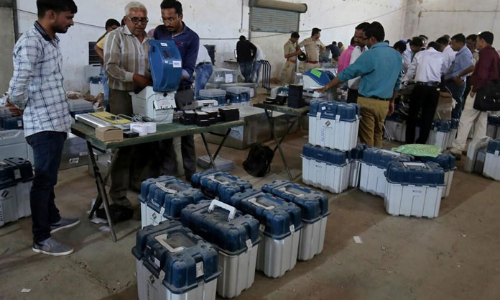Live
- Revanth dares KCR, Harish
- Modi frustrated, afraid of invisible voters: Kharge
- SC seeks clarification from EC on functioning of EVMs
- Vijayawada: ‘People disgusted with YSRCP govt, seek change’
- EC pores over Cong’s plaint against Modi’s speech
- MyVoice: Views of our readers 25th April 2024
- Visakhapatnam: NDA government will make AP corruption-free says Rajnath Singh
- Bengaluru’s Water Future
- The inner drive to help others
- Srikakulam: Jagan cautions people against unholy alliance of TDP-BJP-JSP
Just In

India is expected to hold a general election starting next month in the worlds largest democratic exercise, with Prime Minister Narendra Modi seeking a second straight termThe country of 13 billion people typically holds elections in multiple phases to ensure security across polling stationsMore than 830 million Indians were eligible to vote in the last general election in 2014, more than thre
India is expected to hold a general election starting next month in the world's largest democratic exercise, with Prime Minister Narendra Modi seeking a second straight term.The country of 1.3 billion people typically holds elections in multiple phases to ensure security across polling stations.More than 830 million Indians were eligible to vote in the last general election in 2014, more than three times the voting-age population of the United States in 2017.
But only about 553 million Indians, or 66 percent of all eligible voters, came out to vote five years ago. There were 8,251 candidates from more than 460 political parties.The process is conducted by the Election Commission of India (ECI), an autonomous constitutional authority, with a staff of more than 300 full-time officials at its headquarters in New Delhi.
The fight is for 543 of the 545 seats in India's lower house of Parliament, the Lok Sabha. The remaining two seats are reserved for the Anglo-Indian community, which traces part of its ancestry to Europeans who intermarried with Indians in the colonial era. These members are nominated by India's president. On average, each constituency had 15 candidates during the 2014 election, according to ECI data, with the highest number of hopefuls for one seat recorded at 42.
In 2014, the ECI set up 927,553 polling stations across the country, with each location serving about 900 voters on average. No voter should be more than 2 km away from a polling station, as per ECI guidelines.For such a mammoth exercise, nearly 5 million government officials and security forces are deployed, travelling by foot, road, special train, helicopter, boat and sometimes elephant.
These locations are often in remote areas with few facilities. More than 80,000 stations surveyed by the ECI lacked mobile connectivity, and nearly 20,000 were located in forest or semi-forest areas, according to data released last year.The cost of the entire process in 2014 was 38.7 billion rupees ($552 million), according to ECI estimates.
-Devjyot Ghoshal

© 2024 Hyderabad Media House Limited/The Hans India. All rights reserved. Powered by hocalwire.com







